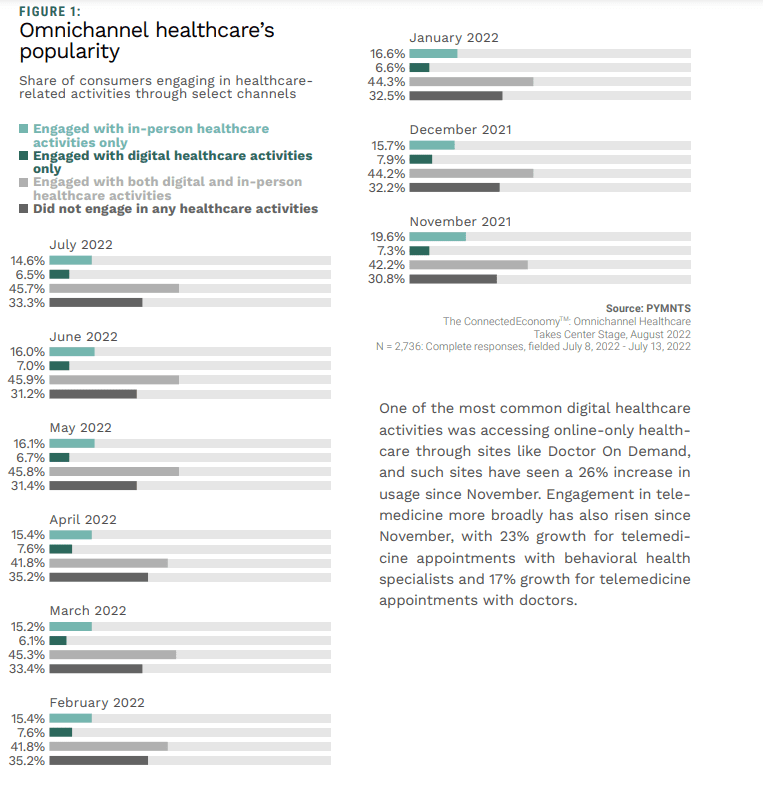
Patients have made their choice clear: Telehealth is now a key component of medical care.
COVID changed nearly every aspect of daily life, including how consumers interact with medical providers. Pre-pandemic visits to the doctor were, for the most part, strictly in person. Then lockdowns occurred, forcing medical professionals to rethink avenues of care and propelling the broad use of telehealth.
Restrictions may have lifted, but consumers are reluctant to quit the convenience of digital health – but aren’t entirely forgoing trips to physical offices. As recently as July 2022, 46% of U.S. patients engaged with healthcare using a mix of online and in-person visits.

Telehealth’s popularity has extended beyond video doctors’ visits, influencing the wellness market. In a September study, PYMNTS found that 57% of consumers had engaged in some preventative care online during the previous month. This represents 148 million consumers of all ages.
Wearables were the most popular type of technology, with 43% of surveyed consumers using such devices to track, store and analyze their health information. The use of mental health apps, including those dedicated to meditation or cognitive behavioral therapy-inspired mood boosters, rose at the fastest rate. During the same period, nearly one-third of consumers reported using a mental health-related app, representing a 32% increase between November 2021 and August 2022.
With such strong consumer appeal, some trailblazers are seeking to further revolutionize possibilities for digital platforms to provide care. For example, Sesame, a pure telehealth platform, is making strict office hours a thing of the past by offering patients 24/7 virtual access to doctors. In an interview with PYMNTS’ Karen Webster, Sesame founder and CEO David Goldhill made a joke to emphasize the importance of his company’s service. “There are no pediatricians at 9 at night, and if you have young kids, as I do, there are no pediatric problems for some reason that exist during the day — 100% of them exist at night for evolutionary biological reasons none of us understand.”
Other companies are trying to bridge the gap between virtual and in-person office visits. One such firm is Sprinter Health, which initially offered at-home visits for blood draws using a staff of full-time phlebotomists and other healthcare workers, with results sent to the patient’s physician. It has since moved on to diabetic retinal and foot exams and A1C draws. The company plans to scale up and include areas such as cancer treatment-related draws in the coming months.
In a separate interview, Sprinter Health CEO Max Cohen remarked to Webster, “It’s much better for the patient, it’s better for the health system to know about capacity planning for the infusion center, it’s better for the provider because they want to get follow ups.”
Healthcare in the U.S. is more cross-channel than ever, with patients regularly accessing telehealth, in-person visits and wellness-related apps. In this environment, delivering patients the healthcare they need and the convenience they want hinges on providers’ ability to connect with their patients virtually and in-office. And there are many options for medical professionals to deliver virtual care through native and third-party platforms.
The patient-driven move toward integrating digital and in-person medical care isn’t disappearing anytime soon – but providers not listening to these demands could be.